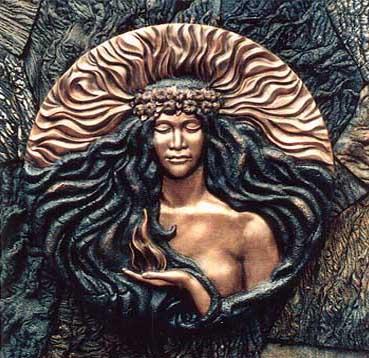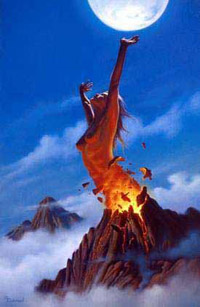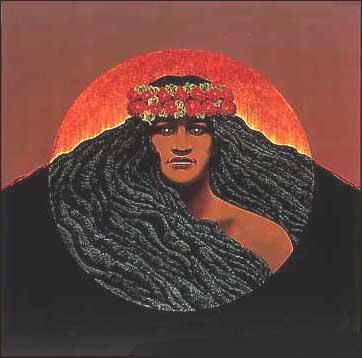Diary of a Heretic
Goddess of Vitality


Over the past 2 years I have been going through a period of adjustment. My concepts of who I am and what I believe in have been changing. The mantle that was Janine has all but been shattered and the new shiny bits are starting to emerge.
Of course this transitional change can have its impact and at times my limits of endurance can become very stretched, and this unsettledness of my emotional & physical surroundings have nearly drained all of my inner resources.
I recently reached a point of sheer frustration and had called out to the Gods with that eternal shout for guidance, but was met with stony still silence. Was I to bear this burden of transformation all alone; was this solitude yet another trial to test the colour of my metal? There is not so much left now of that tower, only the shell that vacillates on the edge of its final disintegration.
Last night in my sanctum of sleep, in that place of endless darkness, an energy revealed itself. Compassionate and loving it was an energy that surprised me for I had not called her name, but she came nevertheless. Her softness was totally unexpected; She said that she had heard my voice and had come to help me in my resurrection. Her name is Pele, and she is the Goddess of Vitality. She is the keeper of the Sacred Fire, she is the ultimate eruption that spews out the cosmic force of life's creation and I am truly humbled by her intervention.
JanineOne of the most dramatic goddesses of Hawaiian mythology, Pele has long lived in Hawaiian hearts and minds as the supreme personification of volcanic majesty and power. Within the Hawaiian cosmos all natural forces are regarded as life forces, related to humanity by common descent from the same ultimate creative spirits. Possessing the power to create new land, Pele also has a volcanic personality. She is by nature impetuous and lusty, jealous, unpredictable, and capable of sudden fury and great violence. She can also be gentle, loving, and as serene as her forests of ferns and flowering trees.
It is this aspect of her personality that becomes evident with this sculpture (at top of page). She is a gatherer of creative energy manifesting as pure compassion and caring for the aina (the land and its spirit) and the people who live on our planet.
PELE, HAWAIIAN GODDESS OF VOLCANOS.
KEEPER OF THE SACRED FIRE.
FILLED WITH LOVE, COMPASSION AND CARING
FOR HER PEOPLE WHO HOLD HER IN HIGH ESTEEM.
Me ke aloha pumehana
Hawaiian kahuna
 |
Pele's esoteric attributes include vitality and psychic awareness. Nervous energy can be harnessed to propel us into vital action, Pele is a fiery vitaliser and a dam breaker. She gives us a voice that resonates with inner security. SUGGESTED MANTRA: VITALITY SUGGESTED AFFIRMATIONS: I am visible My soul is awakened My awesome power is released I am free I am revitalised I am full of fiery passion For my highest good and the highest good of all CHAKRA: Solar plexus GEMSTONES: Clover bark, citron, jasmin |
| Pele has arrived to rekindle your fires of passion. Have you been sitting still for too long? Have you been lulled into sleep by the routine and habits of your life? Have you stepped into the rhythm of another's drum? It is time to awaken your awareness and to come into full consciousness. You must shed the veils of your own illusions to witness the truth. It is the time to explode your potential and power, to move, shake and create new ground. Pele says that when you awaken from your sleep, you will be in touch with your true power! | 
|

Described as "She-Who-Shapes-The-Sacred-Land" in ancient Hawaiian chants, the volcano goddess, Pele, was passionate, volatile, and capricious. In modern times, Pele has become the most visible of all the old gods and goddesses. Dwelling in the craters of the Big Island's Kilauea Volcano, she has been sending ribbons of fiery lava down the mountainside and adding new land around the southeastern shore almost continuously since 1983.
Pele was born of the female spirit Haumea, or Hina, who, like all other important Hawai'i gods and goddesses, descended from the supreme beings, Papa, or Earth Mother, and Wakea, Sky Father. Pele was among the first voyagers to sail to Hawai'i, pursued, legends say, by her angry older sister, Na-maka-o-kaha'i because Pele had seduced her husband. Pele landed first on Kaua'i, but every time she thrust her o'o (digging stick) into the earth to dig a pit for her home, Na-maka-o-kaha'i, goddess of water and the sea, would flood the pits. Pele moved down the chain of islands in order of their geological formation, eventually landing on the Big Island's Mauna Loa, which is considered the tallest mountain on earth when measured from its base at the bottom of the ocean.
Even Na-maka-o-kaha'i could not send the ocean's waves high enough on Mauna Loa to drown Pele's fires, so Pele established her home on its slopes. Here, she welcomed her brothers. A cliff on nearby Kilauea Mountain is sacred to her eldest brother, Ka-moho-ali'i, king of the sharks and the keeper of the gourd that held the water of life, which gave him the power to revive the dead. Out of respect for this brother, to this day, Pele never allows clouds of volcanic steam to touch his cliff.
Her other brothers also still appear on the Big Island mountain; Kane-hekili as thunder, Ka-poho-i-kahi-ola as explosions, Ke-ua-a-kepo in showers of fire, and Ke-o-ahi-kama-kaua in spears of lava that escape from fissures during eruptions.
Of all her siblings, Pele favored her youngest sister Hi'iaka, the most. Pele, Hi'iaka and another sister, Laka, goddess of hula, were all patronesses of the dance, but Hi'iaka was said to have hatched from an egg that Pele kept warm during the long canoe ride to Hawai'i by transporting it in her armpit.
After Hi'iaka grew to womanhood on the Big Island, Pele traveled in spirit form to the north shore of Kaua'i to witness a dance performance at a pahula, or dance platform, that still exists near Ke'e Beach. Here she manifested herself as a desirable young woman, and quickly fell in love with a handsome young chief named Lohi'au. She dallied with Lohi'au for several days, but eventually her spirit had to return to her sleeping body on the Big Island. Upon awakening, Pele sent Hi'iaka to convince Lohi'au to come to her. The sisters extracted vows from each other: Hi'iaka promised not to encourage Lohi'au should he become attracted to her and in return, Pele promised to contain her fires and lava flows so as not to burn a grove of flowering ohi'a trees where Hi'iaka danced with her friend Hopoe.
On Kaua'i, Hi'iaka found that Lohi'au had died of grief after Pele disappeared, but the graceful younger sister was able to restore his spirit to his body, bringing him back to life. Together, the two of them began the journey to the Big Island, but Pele's suspicious nature got the best of her. Because forty days had passed since Hi'iaka had set out on her assigned mission, Pele decided she had been betrayed, and so sent a flood of lava into Hi'iaka's 'ohi'a-lehua grove, killing Hopoe in the process. When Hi'iaka saw the smoldering trees and her dancing friend entombed in lava, she flung herself into the arms of Lohi'au. In retribution, Pele set lose another stream of lava, which killed the mortal Lohi'au, but Hi'iaka, a goddess, could not be destroyed.
The legend has a happy ending, however, as yet another brother of Pele's, Kane-milo-hai, reached out and caught Lohi'au's spirit when he saw it floating past his canoe. He restored the spirit to Lohi'au's body, and once again, the chief was brought back to life. Hi'iaka and Lohi'au returned to Kaua'i to live contentedly.
Legends about Pele, her rivals and her lovers abound. Most of the lovers she took were not lucky enough to escape with their lives when she hurled molten lava at them, trapping them in odd misshapen pillars of rock that dot volcanic fields to this day.
One lover who proved a match for Pele was Kamapua'a, a demi-god who hid the bristles that grew down his back by wearing a cape. The pig god could also appear as a plant or as various types of fish. He and Pele were at odds from the beginning; she covered the land with barren lava, he brought torrents of rain to extinguish her fires and called the wild boars to dig up the land, softening it so seeds could grow.
Pele and Kamapua'a raged against each other until her brothers begged her to give in, as they feared Kamapua'a's storms would soak all the fire sticks and kill Pele's power to restore fire. In Puna, at a place called Ka-lua-o-Pele, where the land seems torn up as if a great struggle had taken place, legend says Kamapua'a finally caught and ravaged Pele. The two remained tempestuous lovers, it is said, until a child was born, then Kamapua'a sailed away and Pele went back to her philandering ways.
Pele's greatest rival was Poliahu, goddess of snow-capped mountains, and a beauty who, like Pele, seduced handsome mortal chiefs. Pele's jealousy flamed after she had a fling with a fickle young Maui chief named 'Ai-wohi-ku-pua, as he was traveling to the Big Island to court a mortal chiefess, Laie. Paddling along the Hana Coast, 'Ai-wohi-ku-pua saw Pele in human form as a beauty named Hina-i-ka-malama, riding the surf. He paused for a brief affair. Then he went on to the Big Island, where Poliahu seduced him. He convinced his personal goddess to release him from his promise to his first love, and went back to Kaua'i with the snow goddess. Pele (as Hina-i-ka-malama) chased after them, eventually winning back the fickle chief, but Poliahu was so vindictive, she blasted the lovers with cold and heat until they separated, and 'Ai-wohi-ku-pua was left with no lover at all.
According to Hawaiian historian David Malo in his book "Hawaiian Antiquities," in old Hawai'i, some gods and goddesses, including Pele, were believed to be akua noho, gods who talked. They could take possession of an earthly being, who became the god's kahu. Malo writes, "The kahu of the Pele deities also were in the habit of dressing their hair in such a way as to make it stand out at great length, then, having inflamed and reddened their eyes, they went about begging for any articles they took a fancy to, making the threat, 'If you don't grant this request, Pele will devour you.' Many people were imposed upon in this manner, fearing Pele might actually consume them." Naturally, people who had seen others destroyed in Pele's fiery lava flows, were terrorized by such a kahu.
Pele has continued to intrigue contemporary men. Not long after the old religion was abolished in 1819, the high chiefess Kapi'olani defied Pele by eating 'ohelo berries at the edge of Halema'uma'u caldera without first offering them to or requesting Pele's permission. In open defiance, Kapi'olani threw stones into the molten lava below. When she was not harmed, she insisted it proved Pele had no power and it was time for Hawaiian people to accept Christianity as their religion. In 1823, when Reverend William Ellis became the first white man to visit Kilauea, most Hawaiians accompanying the expedition were still in awe of the volatile goddess. The hungry missionaries began to eat 'ohelo berries, but were quickly warned to give Pele an offering. Ellis wrote, "We told them ...that we acknowledged Jehovah as the only divine proprietor of the fruits of this earth, and felt thankful to Him for them, especially in our present circumstances."...We traveled on, regretting that the natives should indulge in notions so superstitious." At the crater, the Hawaiian guides "turned their faces toward the place where the greatest quantity of smoke and vapor issued, and, breaking the ('ohelo) branch they held in their hand in two, they threw one part down the precipice, saying:
E Pele, eia ka 'ohelo 'au;
(Oh, Pele, here are your branches)
e taumaha aku wau 'ia 'oe
(I offer some to you)
e 'ai ho'i au tetahi
(some I also eat)."
To this day, tales of Pele's power and peculiarities continue. Whispered encounters with Pele include those of drivers who pick up an old woman dressed all in white accompanied by a little dog on roads in Kilauea National Park, only to look in the mirror to find the back seat empty. Pele's face has mysteriously appeared in photographs of fiery eruptions, and most people who live in the islands-whether Christian, Buddhist, Shinto, or other-speak respectfully of the ancient goddess. After all, she has destroyed more than 100 structures on the Big Island since 1983, and perhaps even more awesome than that, she has added more than 70 acres of land to the island's southeastern coastline.
